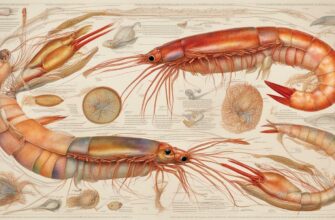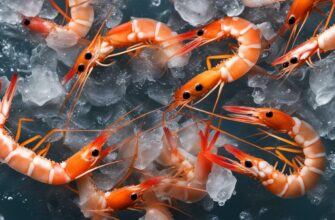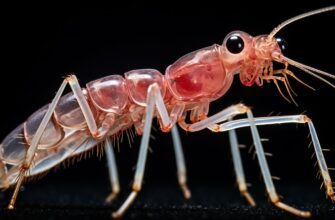As curious beings, humans have always been fascinated by the anatomy of different creatures, and shrimp are no exception. The question of whether shrimp have fins or not has sparked curiosity and debate among researchers and enthusiasts alike. To understand this better, it’s important to have a basic understanding of what fins are and their function in aquatic animals.
- The Anatomy of a Shrimp
- Understanding Shrimp Appendages
- The Fin Debate: Do Shrimp Have Fins?
- Other Adaptations for Movement in Shrimp
- Frequently Asked Questions about Shrimp Fins
- Do shrimp have fins?
- What are the structures that are often mistaken for fins in shrimp?
- Why is it important to understand the anatomy of shrimp?
- Do different types of shrimp have different fins or fins-like structures?
- Are there any risks associated with misidentifying parts of a shrimp’s anatomy as fins?
The Anatomy of a Shrimp
Before we delve into the question of whether shrimp have fins, let’s first explore the different body parts that make up these fascinating creatures.
A shrimp’s body can be divided into three main parts: the head, thorax, and abdomen. The head, or cephalothorax, contains the shrimp’s brain, eyes, antennae, and mouthparts. The thorax is home to the shrimp’s legs and claws, while the abdomen contains its internal organs and reproductive structures.
Each body part plays a unique role in the shrimp’s survival. The head, for example, is responsible for sensing food and potential predators, while the thorax is important for movement and defense.
When we think of fins, we typically picture flat, fan-like structures used for swimming. While shrimp don’t have typical fins, they do have appendages that help them move through the water. For example, the pleopods located on the underside of the abdomen are used for swimming and can help propel the shrimp forward.
So while shrimp don’t have fins in the traditional sense, they do have various appendages that aid in their movement and survival in the aquatic environment.
Understanding Shrimp Appendages
Shrimp have a variety of appendages that are used for different purposes, including swimming and movement. These appendages are key parts of a shrimp’s anatomy and hold important clues as to whether or not shrimp have fins.
One set of appendages that are commonly mistaken for fins are the pereiopods, which are the walking legs located on the thorax of the shrimp. While these legs are crucial for locomotion and movement, they do not function in the same way as fins do and are not considered true fins.
Another set of appendages that are important for swimming are the pleopods, which are located on the underside of the abdomen. The pleopods are used for generating forward motion and stability in the water, but again, they are not considered true fins.
So, do shrimp have fins? The answer is no, but they do have appendages that are used for swimming and movement. While these appendages may resemble fins to some extent, they do not serve the same function and are not classified as true fins in the traditional sense.
It is important to understand the nuances of shrimp anatomy and the specific purposes of each appendage in order to fully appreciate the complexity and beauty of these aquatic creatures.
The Fin Debate: Do Shrimp Have Fins?
One of the most common questions about shrimp anatomy is whether or not shrimp have fins. The answer to this question is not as straightforward as one might think. While some researchers argue that shrimp do have fins, others believe that the structures often mistaken for fins are actually different types of appendages that serve a similar purpose.
So, what exactly are fins? Fins are flattened, usually paddle-shaped structures that are found on aquatic animals. They generally help with swimming, stability, and maneuverability. In contrast, the appendages of a shrimp are jointed and more specialized for specific functions.
One reason the debate over shrimp fins is ongoing is because of the different structures that can be mistaken for fins. For example, some researchers argue that the tail fan of a shrimp is a type of fin. This structure is muscular and used for swimming, which are characteristics of a fin. However, others point out that the tail fan is not flattened like a typical fin and that its movements are controlled by different muscles. Therefore, it cannot be classified as a true fin.
Another structure that is often mistaken for a fin is the pleopod, which is a swimming appendage located on the abdomen of the shrimp. However, pleopods are not flattened like fins and are used primarily for reproduction. While they do assist with swimming, they are not comparable to true fins in terms of form and function.
In summary, the question of whether shrimp have fins is not a black-and-white answer. While some structures of a shrimp may have characteristics of fins, they are not the same as true fins found on other aquatic animals. Therefore, it is more accurate to say that shrimp do not have fins in the traditional sense, but rather possess various appendages that aid in swimming and locomotion.
Other Adaptations for Movement in Shrimp
While shrimp may not have true fins, they are equipped with other adaptations that allow them to move and swim efficiently. One such feature is their muscular tail fan, also known as the uropod. This structure generates powerful jet propulsion that propels the shrimp through the water.
Additionally, shrimp have specialized swimming mechanisms that help them move in different directions. They have five pairs of pleopods, or swimmerets, located on their abdomen. These small appendages beat rhythmically to produce forward motion and help stabilize the shrimp’s body.
Shrimp also have walking legs, or pereiopods, that are used for crawling along the ocean floor. These legs feature sharp claws that allow the shrimp to grasp onto surfaces and move effectively in different directions.
In summary, while shrimp may not have true fins, they possess a variety of unique adaptations that allow them to navigate their aquatic environments with agility and efficiency.
Frequently Asked Questions about Shrimp Fins
As the debate about whether shrimp have fins continues, many questions arise about the anatomy of these intriguing creatures. Here are some of the most frequently asked questions about shrimp fins:
Do shrimp have fins?
The answer to this question is not a straightforward one. While shrimp do have structures that aid in locomotion and could be mistaken for fins, they do not have true fins like those found on fish.
What are the structures that are often mistaken for fins in shrimp?
The structures that are often mistaken for fins in shrimp are their pleopods and uropods. These are appendages that are used for swimming and helping the shrimp change direction, but they do not have the same structure as true fins.
Why is it important to understand the anatomy of shrimp?
Understanding the anatomy of shrimp is important for a variety of reasons, from a scientific perspective to a culinary one. Knowing the different parts of a shrimp and their functions can help us study and better appreciate these creatures, as well as prepare them for cooking in the most delicious way possible.
Do different types of shrimp have different fins or fins-like structures?
Yes, different types of shrimp may have variations in their appendages that aid in swimming and locomotion. Some shrimp may have more pronounced pleopods or uropods, while others may have specialized structures for swimming in certain environments.
Are there any risks associated with misidentifying parts of a shrimp’s anatomy as fins?
While misidentifying parts of a shrimp’s anatomy as fins may not have serious consequences, it can lead to confusion and inaccurate information. It is important to use proper terminology and understand the anatomy of these creatures in order to properly study and appreciate them.
By understanding the anatomy of shrimp and the debate about their fins, we can gain a deeper appreciation for these fascinating creatures and their unique adaptations for movement in the water.









